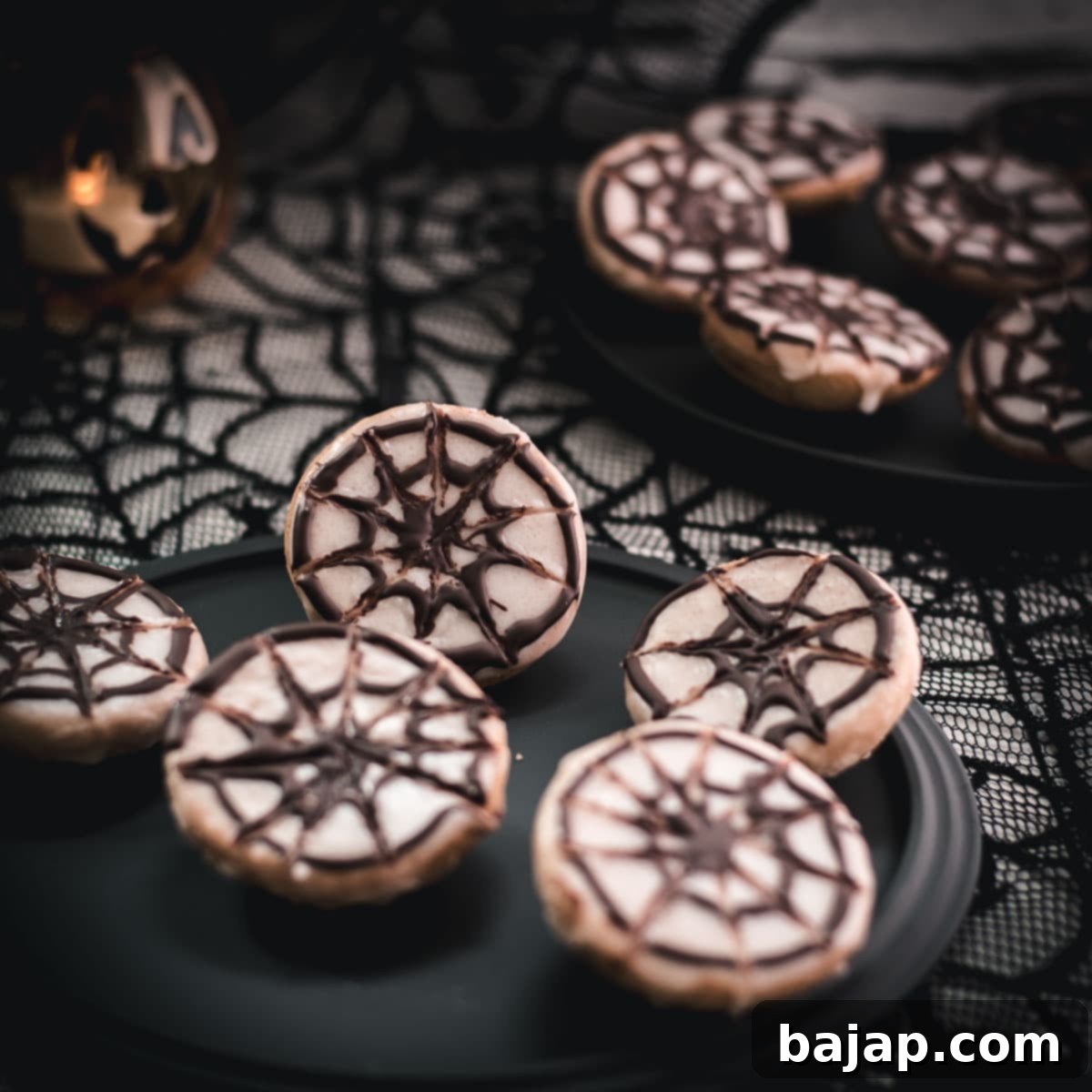Spooky & Sweet: The Ultimate Guide to Easy Halloween Spiderweb Cookies
Get ready to cast a spell of deliciousness this Halloween with these captivating spiderweb cookies! These treats are more than just eye-catching; they’re incredibly fun to make, surprisingly simple, and absolutely perfect for a memorable baking session with the kids. Imagine their delight as they help create these edible works of art, ideal for any Halloween party or a cozy evening of spooky fun.
Our spiderweb cookies feature a rich and delectable vanilla custard dough that’s gently piped onto baking paper, creating perfectly sized canvases for your creative decorations. Once baked to golden perfection, these cookies are generously coated with a smooth white icing, providing the perfect backdrop for the intricate dark chocolate spiderwebs. The contrast is simply stunning, making them an undeniable highlight on any Halloween dessert table.
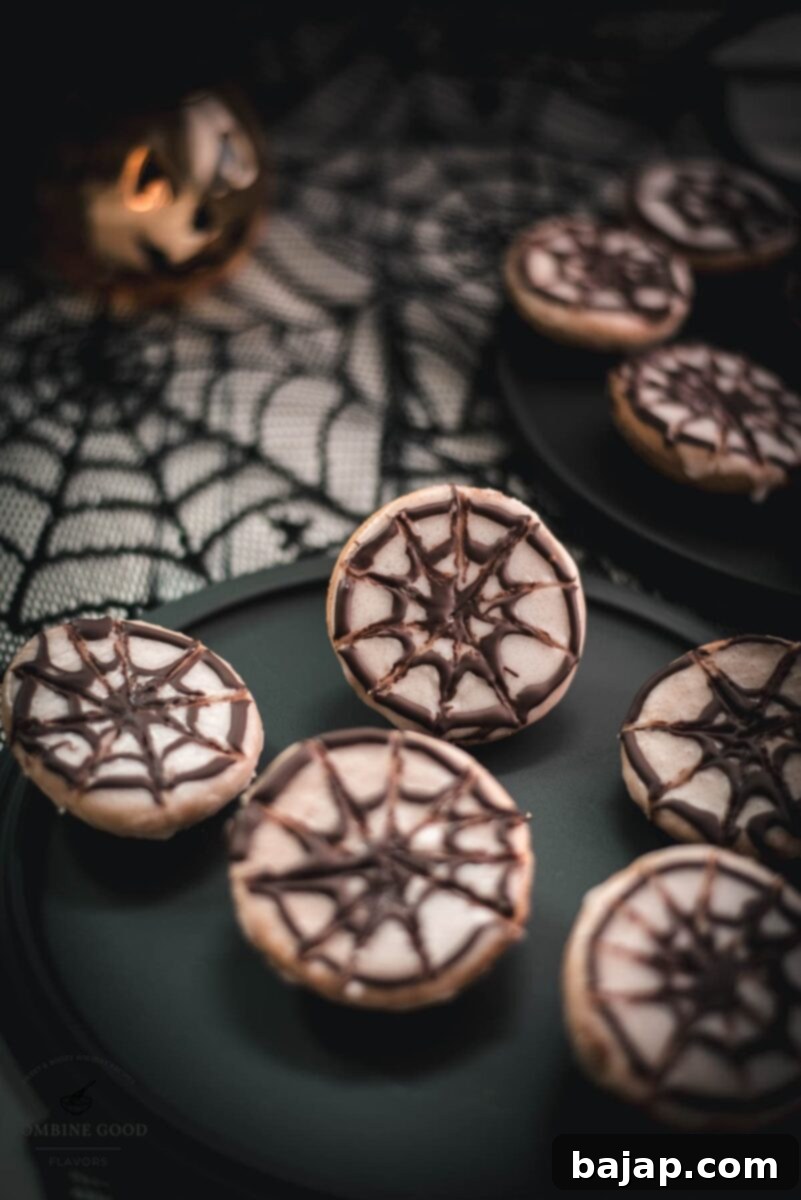
These charming Halloween spiderweb cookies are an absolute must for your seasonal festivities. They pair wonderfully with other spooky delights like a creamy spider web no-bake cheesecake. For the adults looking for a spirited touch, a vibrant spooky red spider cocktail completes the eerie ambiance. With this recipe, you’re guaranteed to have a Halloween hit that impresses everyone. So, gather your ingredients, unleash your inner baker, and enjoy a Happy Halloween baking adventure!
🥘 Ingredients for Your Spooky Spiderweb Cookies
Crafting the perfect spiderweb cookie starts with selecting the right ingredients. Each component plays a vital role in achieving that desirable texture and custardy flavor that makes these cookies so special. Here’s a closer look at what you’ll need for both the delightful cookie dough and the ghostly white glaze.
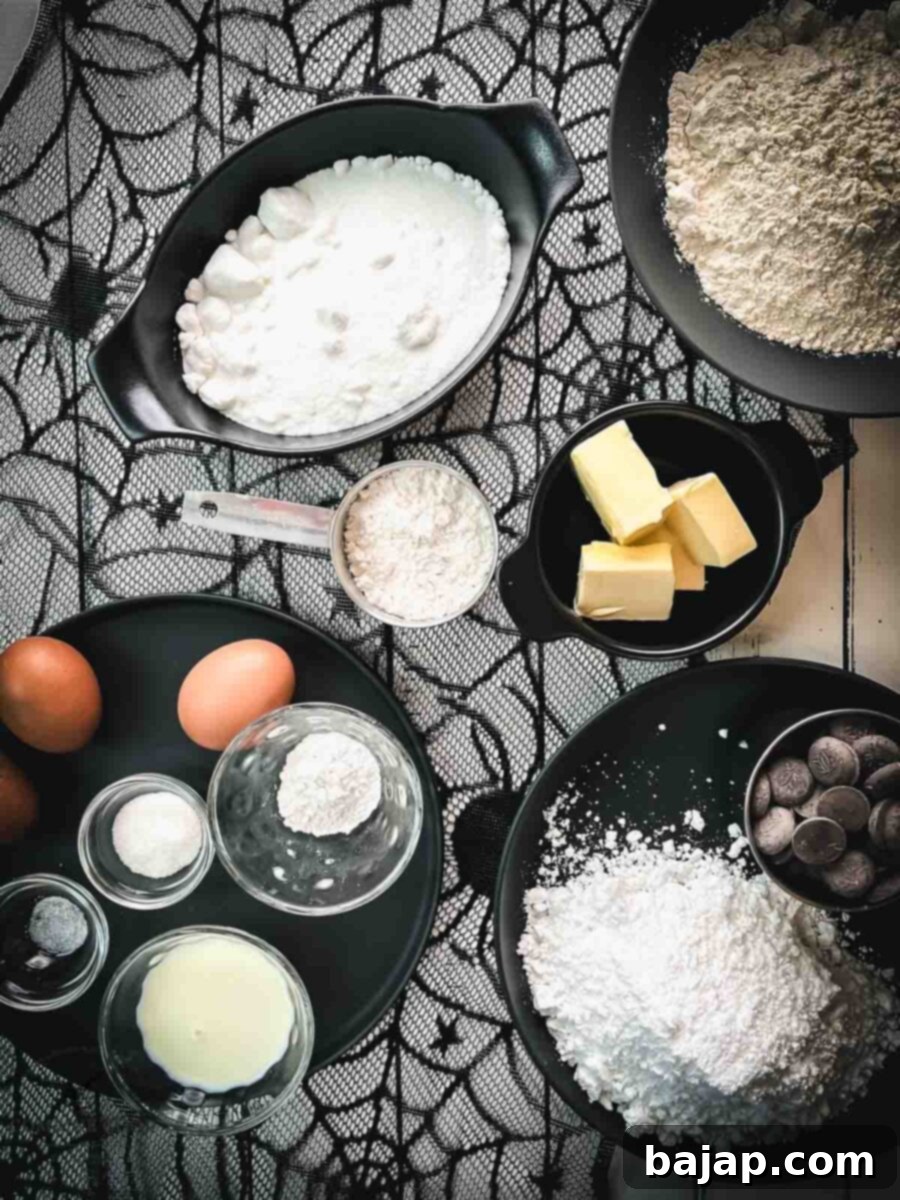
For the Irresistible Cookie Dough
- Butter, soft: This is crucial for achieving a smooth, well-combined dough. Softened butter creams beautifully with sugar, incorporating air for a lighter cookie.
- Granulated sugar: Provides the essential sweetness and contributes to the cookie’s structure, giving it that perfect bite.
- Vanilla sugar: Elevates the flavor profile with an aromatic depth that plain vanilla extract simply can’t match. I personally love using my homemade vanilla sugar for an extra special touch.
- Salt: A pinch of salt is a baking secret! It perfectly balances and enhances all the other wonderful flavors in the dough, preventing the cookies from tasting overly sweet.
- Eggs (M): Medium-sized eggs act as a binder, holding all the ingredients together, while also adding richness and moisture to ensure a tender cookie.
- Vanilla pudding powder: This is the secret ingredient that gives our spiderweb cookies their distinctive, rich, and custardy flavor and contributes to their wonderfully soft texture.
- Cake flour: Known for its lower protein content, cake flour is key to creating an exceptionally tender and delicate cookie that practically melts in your mouth.
- Baking powder: This leavening agent is essential for giving the cookies a slight lift, making them fluffy and light rather than dense.
- Milk: Adds the necessary moisture to the dough, helping all the ingredients come together to create a smooth, pipeable consistency.
For the Glaze and Striking Spiderwebs
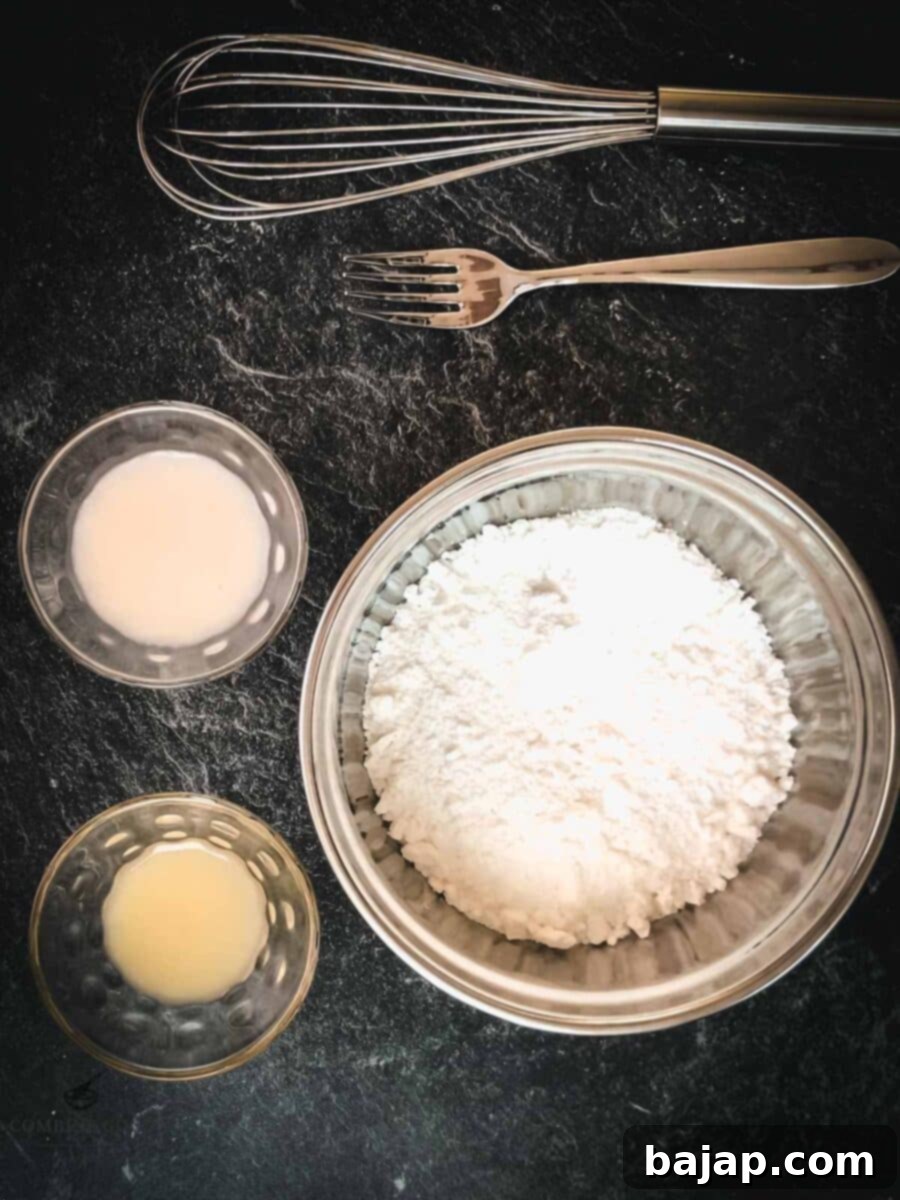
- Powdered sugar: Also known as confectioners’ sugar, its fine texture is perfect for creating a smooth, lump-free, and delightfully sweet glaze.
- Lemon juice: A splash of lemon juice adds a wonderful tangy counterpoint to the sweetness of the glaze, brightening the overall flavor. I highly recommend using freshly squeezed lemon juice for the best results. For tips, check out my posts on “how much lemon juice is in one lemon” and a detailed guide to “freshly squeezed lemon juice”.
- Rice milk: This ingredient is fantastic for keeping the glaze dairy-free, while also providing a light and fluid consistency that’s easy to dip your cookies into.
- Dark chocolate coating for the spider’s web: Melted dark chocolate is ideal for drawing those intricate, spooky spider web designs. Its deep color provides a striking contrast against the white glaze, making your cookies truly pop. Opt for a good quality dark chocolate for optimal flavor and melting consistency.
For precise measurements and a handy printable version, refer to the full recipe card below.
🔪 Step-by-Step Instructions: Crafting Your Spiderweb Masterpieces
Creating these Halloween spiderweb cookies is a fun and rewarding process. Follow these detailed steps to ensure your cookies turn out perfectly spooky and delicious!
Step 1: Prepare Your Baking Station
Start by preheating your oven to 338°F (170°C) fan. Proper oven temperature is key for even baking. Line two standard baking trays with parchment paper. This prevents sticking and makes cleanup a breeze.
Step 2: Cream the Wet Ingredients
In a food processor fitted with a whisk attachment (or using a stand mixer), combine the softened butter, granulated sugar, vanilla sugar, and a pinch of salt. Beat these ingredients together until the mixture is wonderfully light, fluffy, and creamy. This creaming process incorporates air, contributing to the cookies’ tender texture.
Step 3: Combine Dry and Wet
Gradually add the eggs to the creamed mixture, one at a time, ensuring each egg is fully incorporated before adding the next. This helps to create a smooth emulsion. Follow with the vanilla custard powder, cake flour, and baking powder. Finally, slowly mix in the milk until a smooth, uniform dough forms. Be careful not to overmix, which can lead to tough cookies.
Step 4: Pipe Your Cookies
Transfer the cookie dough into a piping bag. You don’t need a special tip for this; simply snip off a small piece from the pointy end of the bag. Pipe small, round cookies onto the prepared baking trays, aiming for roughly 1.5-inch (4cm) in diameter. Leave a little space between each cookie as they will spread slightly.
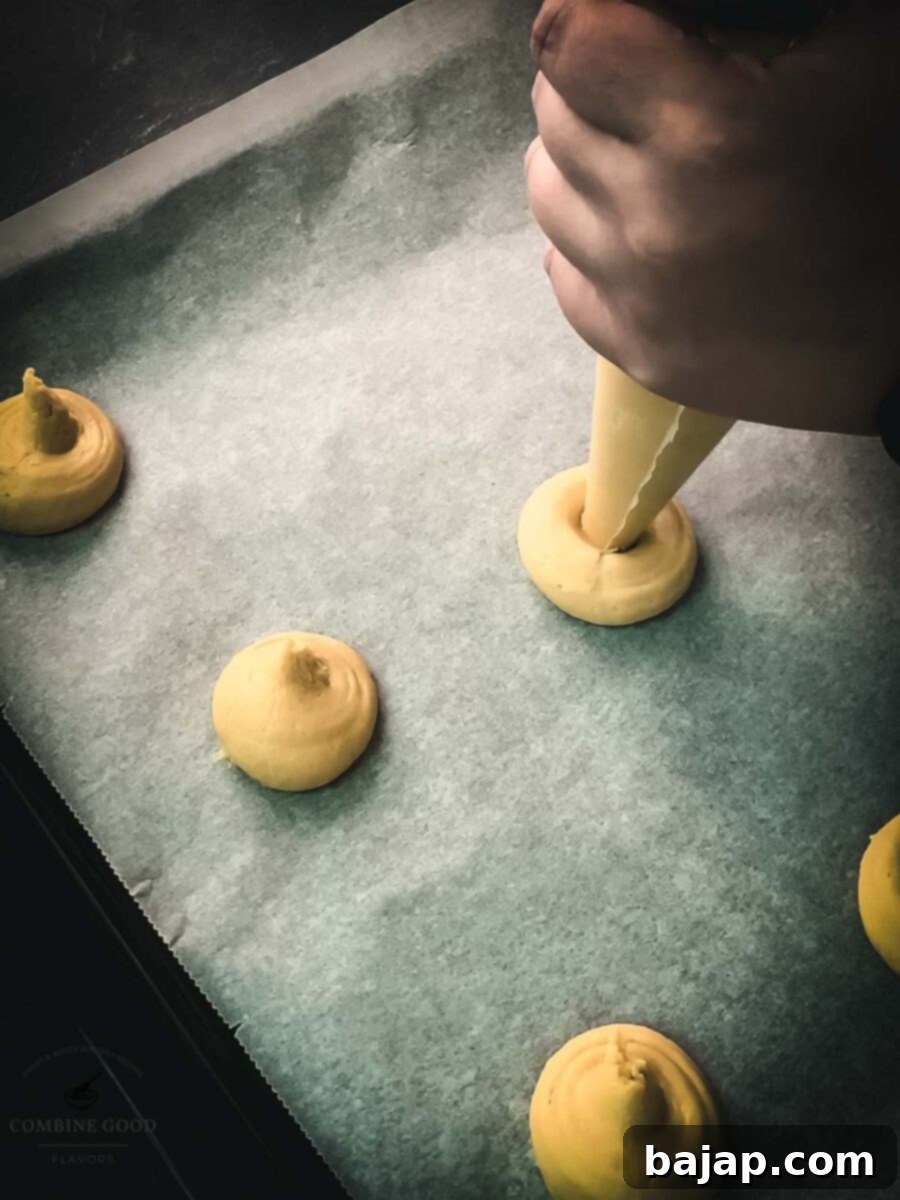
Step 5: Bake and Cool
Bake the cookies in your preheated oven for about 15 minutes, or until the edges are lightly golden and the centers are set. Once baked, transfer them immediately to a cooling rack to cool completely. {Note: Don’t be concerned if the cookies have a slightly rounded top; the beautiful spider web decoration will be applied to the flat, underside of the cookie for a perfectly smooth surface.}
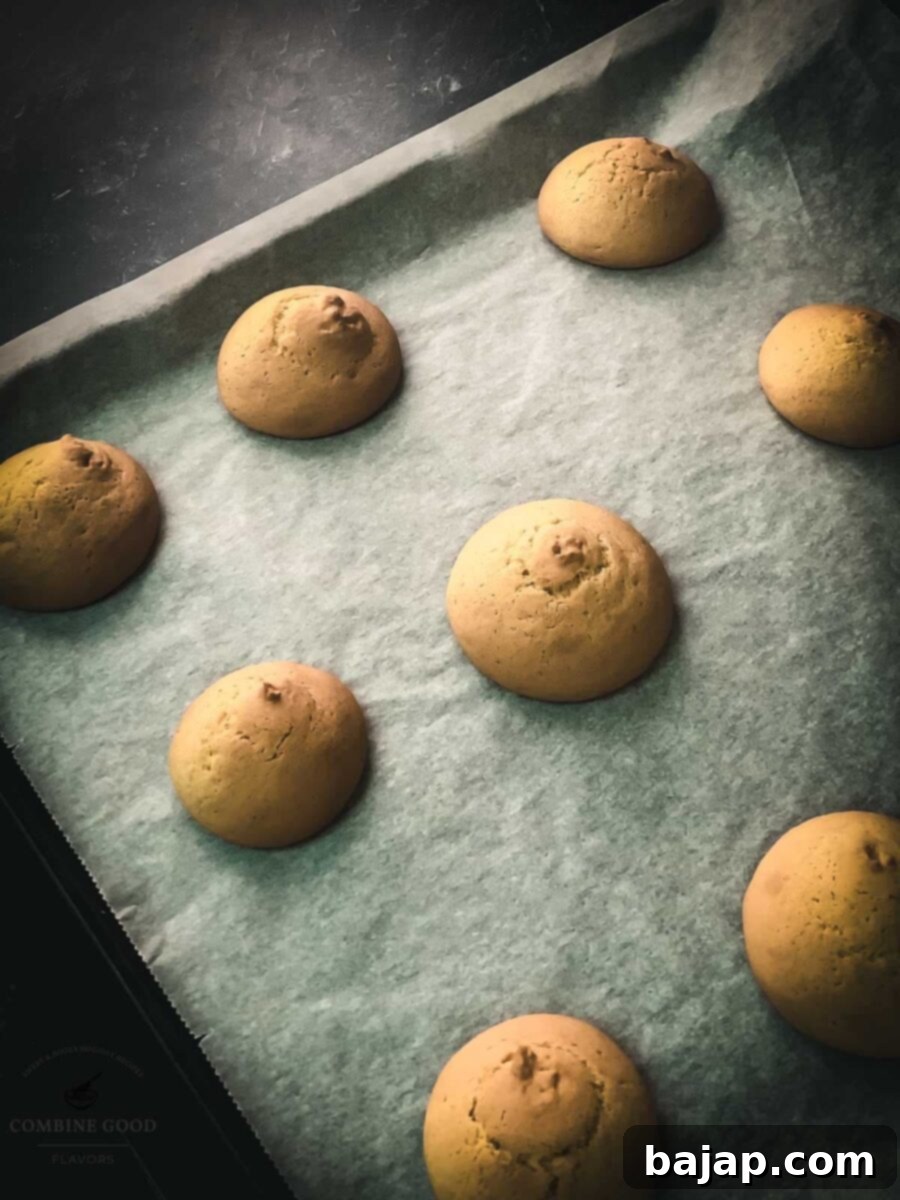
Step 6: Prepare Your Chocolate for Decorating
Melt the dark chocolate using your preferred method (details on popular melting techniques are provided further down in this article). Ensure the chocolate is smooth and fluid for easy piping and intricate designs.
Step 7: Whisk Up the Icing
In a clean mixing bowl, whisk together the powdered sugar, freshly squeezed lemon juice, and rice milk until you achieve a perfectly smooth and pourable icing. The consistency should be thin enough to dip but thick enough to coat the cookies evenly.
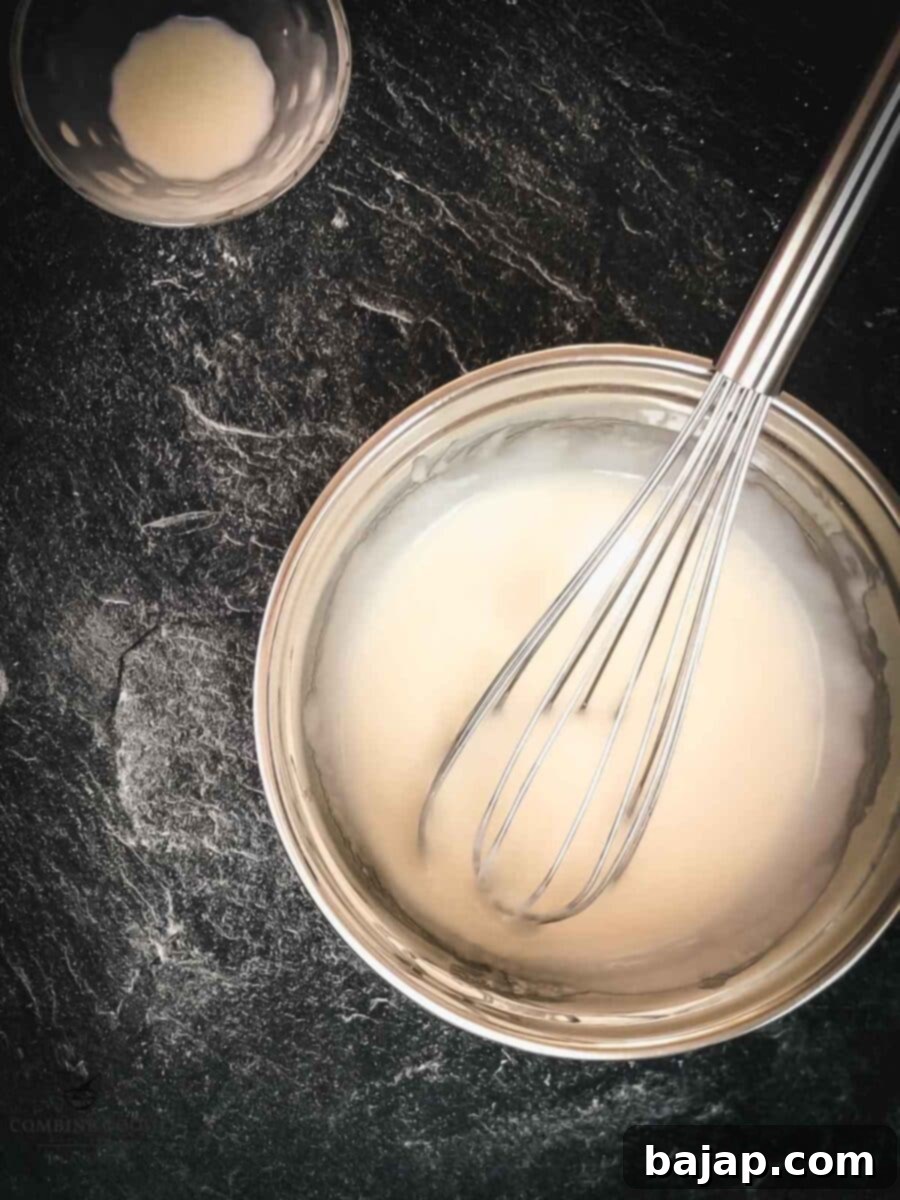
Step 8: Dip and Dot the Chocolate
Carefully dip the flat side of each cooled cookie into the smooth white icing, allowing any excess to drip off. Place the iced cookie on a clean surface or parchment paper. While the icing is still wet, use the melted dark chocolate to create a small dot in the very center of the cookie. Then, working outwards from the center dot, draw 2-3 concentric circles of chocolate around it.
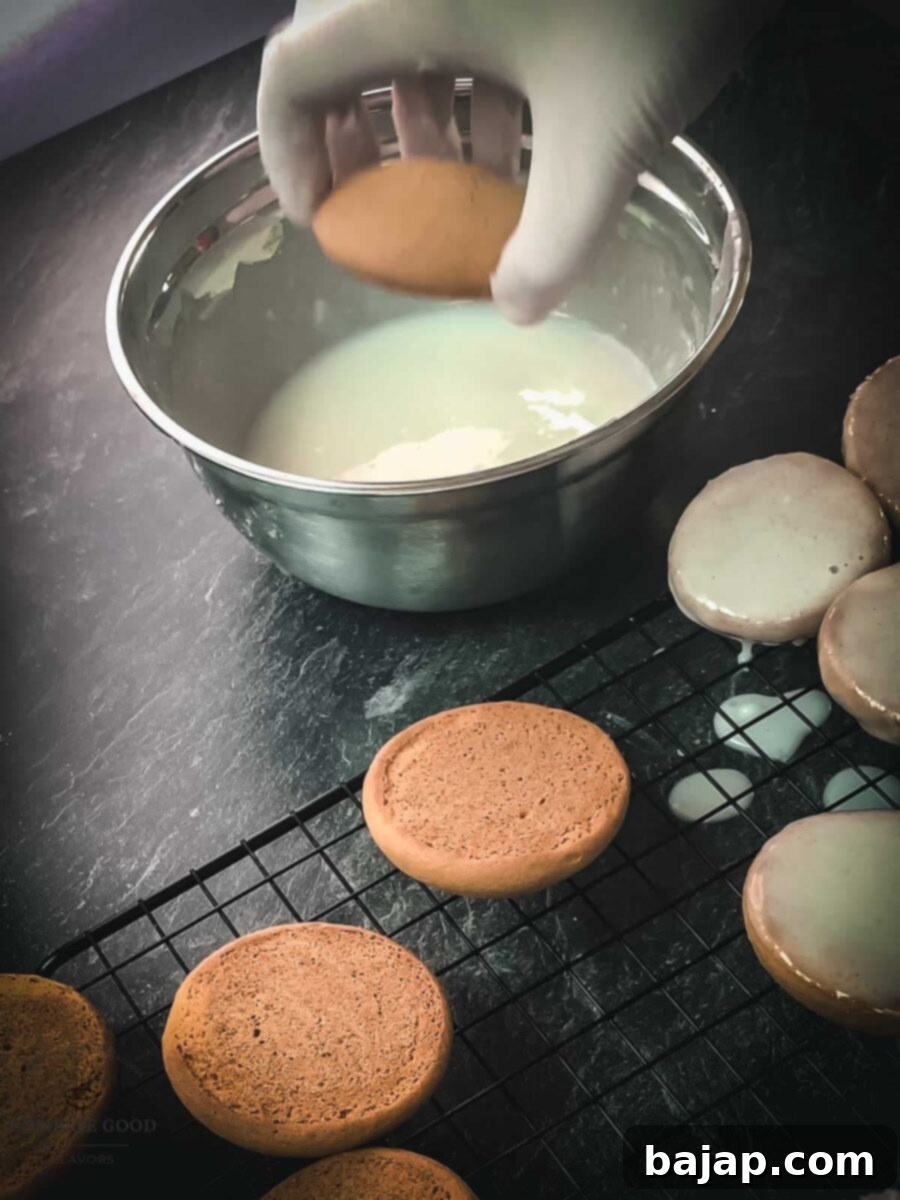
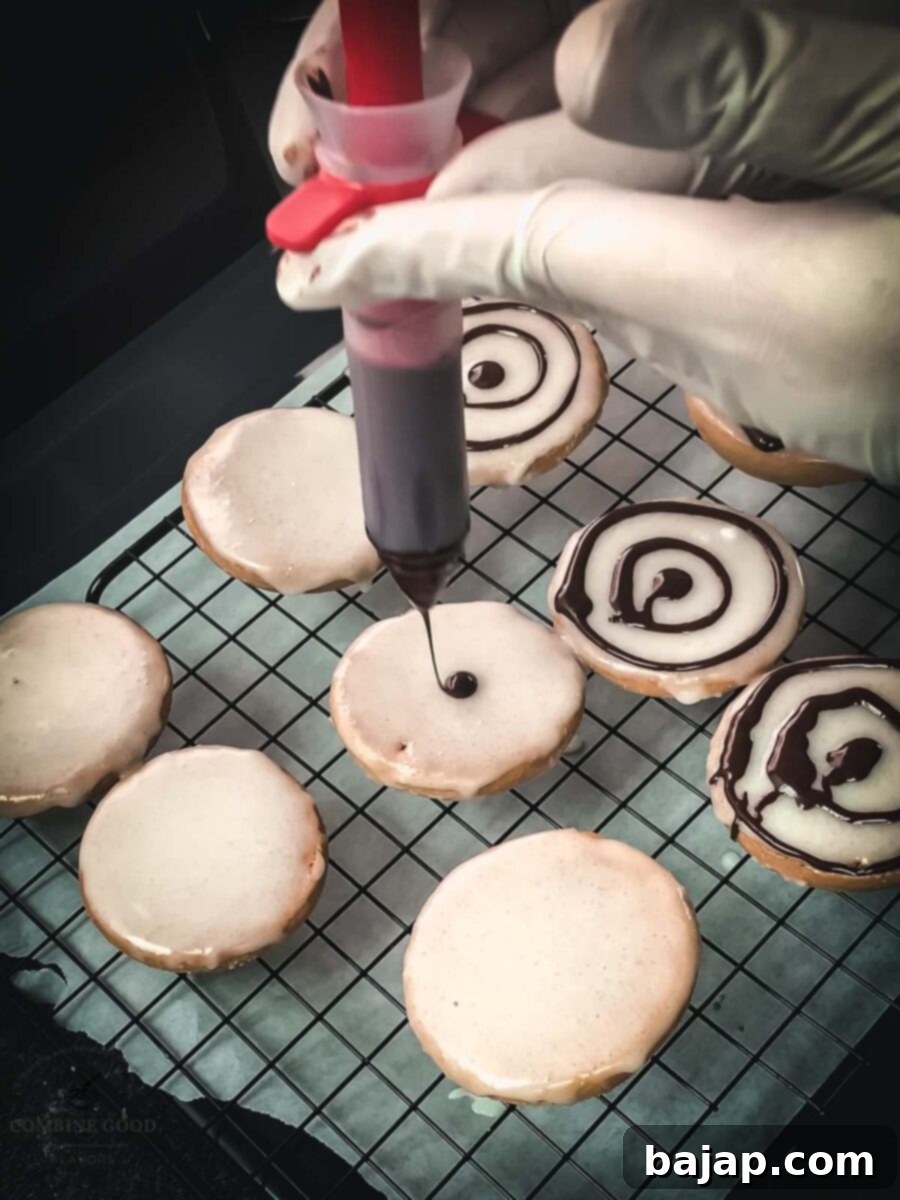
Step 9: Create the Iconic Spiderweb Pattern
Immediately after drawing the chocolate circles (while the icing is still wet), take a clean toothpick. Starting from the chocolate dot in the center, gently drag the toothpick outwards through the chocolate circles, creating radial lines. Repeat this several times around the cookie to form a striking spiderweb pattern. It’s a simple trick that yields impressive results!
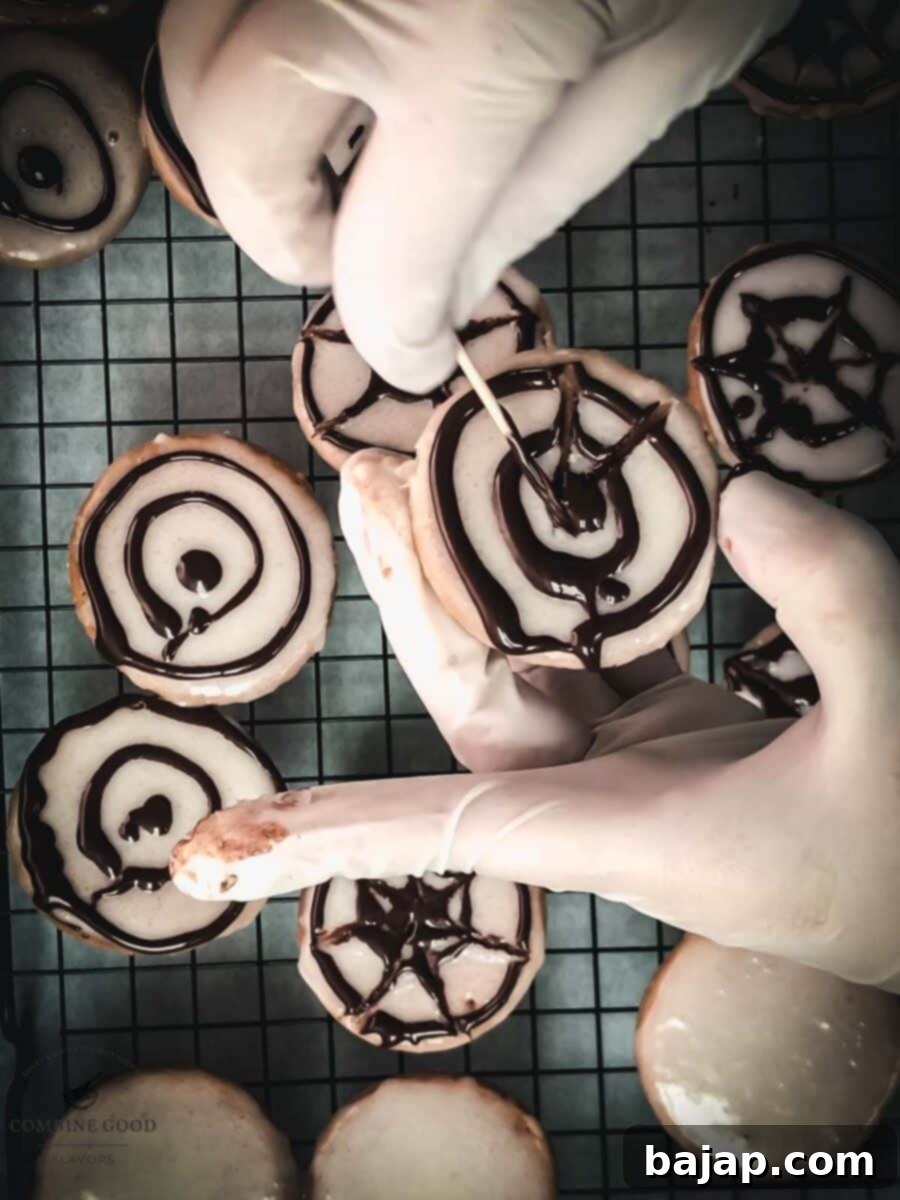
Step 10: Let Them Dry and Set
Once all your spiderweb cookies are decorated, carefully transfer them back to a cooling rack. Allow them to dry undisturbed for about an hour, or until the icing and chocolate have fully set. This ensures your beautiful designs remain intact and the cookies are ready for serving or storing.
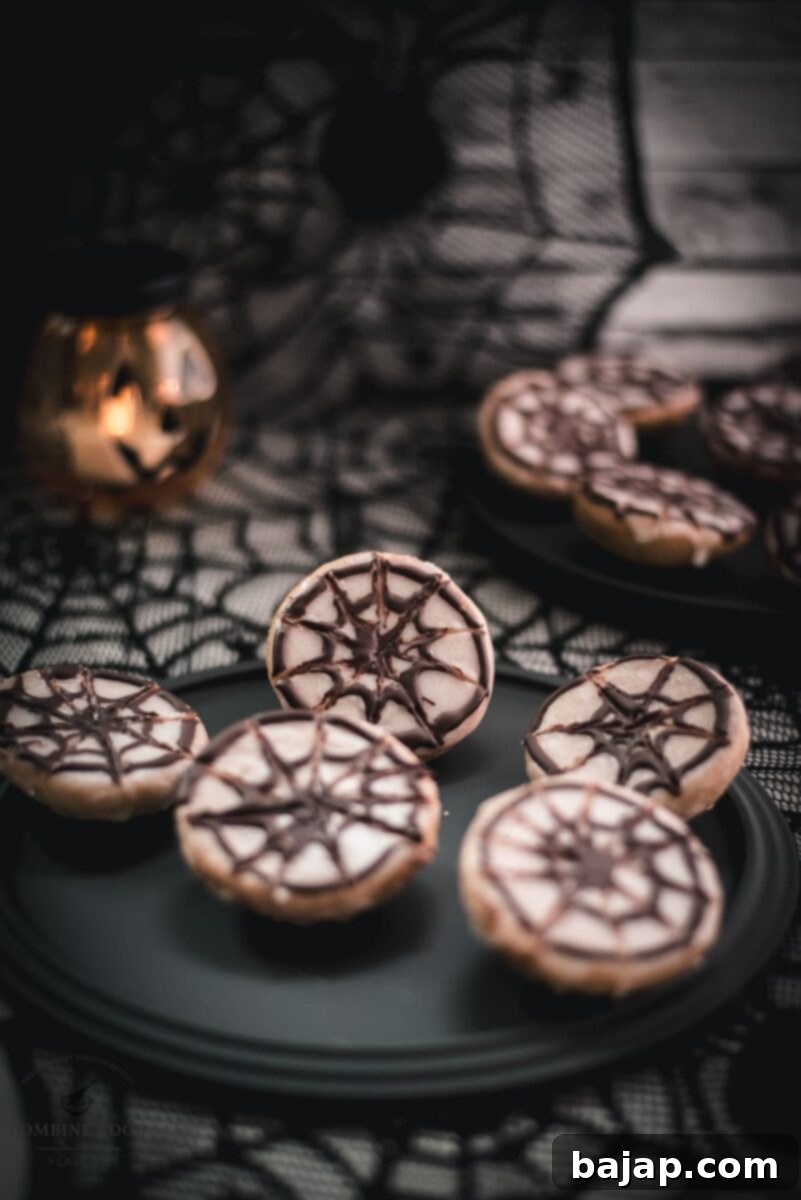
🍽 Essential Equipment for Perfect Halloween Cookies
Having the right tools on hand can make all the difference in your baking experience. Here’s a list of the equipment you’ll need to successfully create these delightful Halloween spiderweb cookies:
- Kitchen machine with whisk attachment: A stand mixer, like my trusty KitchenAid stand mixer, is ideal for creaming butter and sugar, ensuring a smooth and airy dough.
- Mixing bowls: You’ll need a few bowls for separating wet and dry ingredients and for preparing the glaze.
- Two baking trays & parchment paper: Essential for baking your cookies without sticking and for easy cleanup.
- Piping bag: A simple piping bag is all you need for shaping the cookie dough. No fancy tip required; just cut a small opening at the pointy end.
- Cooling rack: Allows air to circulate around the cookies, ensuring they cool evenly and helps the glaze set properly.
- Toothpick: Your secret weapon for creating those iconic, intricate spiderweb patterns on the wet icing.
- Whisk & a fork: A whisk is perfect for blending the glaze ingredients until smooth, and a fork can be useful for dipping cookies or making slight adjustments.
- Cake decorating pen: While optional, a cake decorating pen can be incredibly helpful for precise chocolate dots and circles, especially if you’re aiming for very neat designs.
💭 Top Tips for Perfect Spiderweb Cookies
Achieving bakery-quality spiderweb cookies is easier than you think with a few helpful pointers. Beyond the basic recipe, here are some top tips to elevate your baking game and ensure success:
- Consistent Piping: Try to pipe your cookie dough in uniform sizes. This ensures even baking and a consistent look for your finished spiderwebs. If your hands get tired, take a short break or have a helper!
- Working with Icing: The key to a beautiful spiderweb is working quickly while the glaze is still wet. Have your melted chocolate ready before you start dipping your cookies.
- Cleaning Decorating Tools: I recently tried using a silicone decorating pen for the melted chocolate, and it worked wonderfully for precision. While it’s often advertised as dishwasher safe, I found it best to hand wash off any chocolate residue first to prevent it from solidifying and getting stuck in hard-to-reach places. This makes subsequent cleanups much easier!
- Storage: Once completely dry, store your spiderweb cookies in an airtight container at room temperature for up to 3-5 days. This will keep them fresh and maintain their delightful texture.
- Make Ahead: The cookie dough can be prepared a day in advance and stored in the refrigerator. Just bring it back to room temperature for about 30 minutes before piping.
- Involve the Kids: This recipe is fantastic for involving younger bakers! Let them take charge of dipping the cookies and drawing the chocolate circles. It’s a fun and creative way to get them excited about Halloween baking.
🍫 Mastering the Art of Melting Chocolate for Decorating
Melting chocolate properly is crucial for achieving smooth, beautiful spiderweb designs. Whether you’re using a simple water bath or a specialized tempering unit, understanding the correct technique will prevent your chocolate from seizing or becoming clumpy. Here are two reliable methods:
The Gentle Water Bath Method (Bain-Marie):
This classic method uses indirect heat to melt chocolate slowly and evenly, preventing it from burning. You will need two pots of different sizes: one larger pot and one smaller pot that fits snugly on top without touching the water. Fill the larger pot with about 3-4 finger-widths of water and bring it to a gentle simmer over moderate heat. Place the chopped chocolate into the smaller, dry pot. Position the smaller pot over the simmering water, ensuring its bottom does not touch the water. The steam will gently melt the chocolate. Stir continuously with a spatula until the chocolate is completely smooth and free of lumps. Remove from heat immediately once melted.
Using a Tempering Unit (Chocolate Melter):
For a more controlled and precise melt, a tempering unit is an excellent tool. Simply add your chopped chocolate couverture to the tempering unit and set it to the appropriate melting temperature. Different types of chocolate require different temperatures to melt perfectly:
- White and milk chocolate: Approximately 40 °C (104 °F)
- Dark chocolate: Approximately 50 °C (122 °F)
The tempering unit will maintain the ideal temperature, ensuring your chocolate stays fluid and ready for decorating without the risk of overheating. This method is especially great if you plan to do a lot of chocolate work.
🍫 Download Your Free Chocolate Workbook
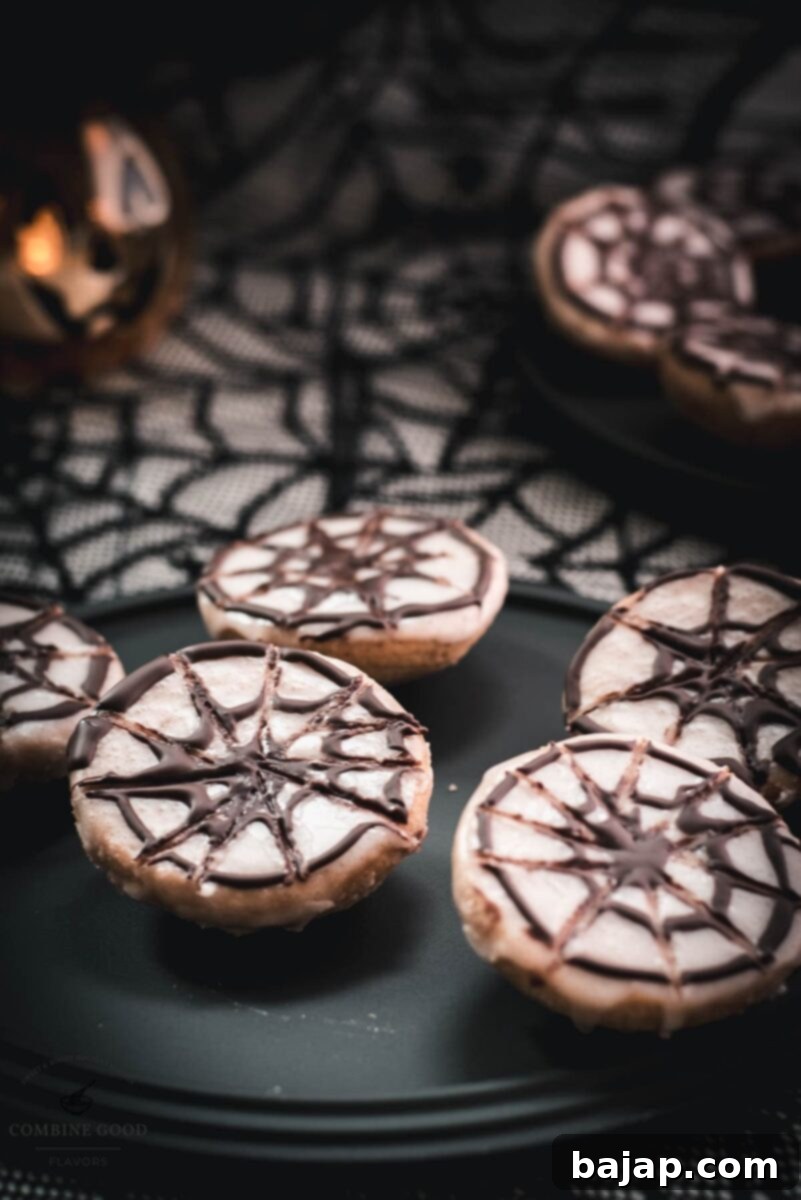
🍪 Creative Substitutions for Your Spiderweb Cookies
While the original recipe for these Halloween spiderweb cookies is fantastic, sometimes you need to adapt to dietary restrictions, preferences, or simply what you have on hand. Here are some smart substitution ideas for both the cookie dough and the glaze, ensuring everyone can enjoy these spooky treats.
Cookie Dough Alternatives
- Butter, soft: For a dairy-free option, substitute with an equal amount of high-quality margarine or your favorite dairy-free butter alternative. The texture may vary slightly.
- Granulated sugar: You can swap granulated sugar for coconut sugar (which will add a subtle caramel note), light brown sugar (for a chewier cookie), or a granulated sugar substitute like erythritol or stevia for a lower-sugar version.
- Vanilla sugar: If you don’t have vanilla sugar, simply use regular granulated sugar and add an extra teaspoon of pure vanilla extract for that lovely aromatic touch.
- Salt: Fine sea salt or kosher salt can be used interchangeably with regular table salt to enhance the flavors.
- Eggs (M): For an egg-free cookie, use flax eggs (mix 1 tablespoon of flaxseed meal with 3 tablespoons of water per egg, let sit for 5 minutes to thicken) or a commercial egg replacer according to package directions.
- Vanilla pudding powder: An instant vanilla pudding mix or a generic custard powder will work perfectly in place of dedicated vanilla pudding powder, maintaining that signature custardy flavor.
- Cake flour: If you don’t have cake flour, you can create a suitable substitute by using all-purpose flour. For every cup of cake flour needed, measure out 1 cup of all-purpose flour, remove 2 tablespoons, and replace it with 2 tablespoons of cornstarch. Sift well before using.
- Baking powder: In a pinch, you can create a baking powder substitute by combining baking soda and cream of tartar in a 1:2 ratio (e.g., ½ teaspoon baking soda + 1 teaspoon cream of tartar for 1 ½ teaspoons baking powder).
- Milk: Any plant-based milk such as almond milk, soy milk, or oat milk can seamlessly replace cow’s milk, keeping the recipe dairy-free without compromising consistency.
Glaze & Chocolate Alternatives
- Powdered sugar: For a sugar-free glaze, use a powdered sugar substitute like monk fruit sweetener or erythritol blend that is specifically designed for icing.
- Lemon juice: If lemon juice isn’t available, lime juice provides a similar tangy zest. In a true emergency, a tiny dash of apple cider vinegar can provide a touch of acidity, but use sparingly.
- Rice milk: Feel free to use any other plant-based milk (almond, soy, oat) or even regular dairy milk if dairy is not a concern.
- Dark chocolate coating for the spider’s web: Dairy-free dark chocolate is an excellent substitute for those with allergies. Alternatively, regular melted chocolate chips (semisweet or bittersweet) can be used, though they might be slightly thicker and require a bit more finesse for drawing fine lines. You can also use white chocolate (colored with food coloring for a spooky effect) or even candy melts.
Other Spooktacular Halloween Recipes for You to Try
If these spiderweb cookies have ignited your Halloween spirit, you’ll love exploring these other festive recipes. From hauntingly good drinks to eerie desserts, we have everything you need to create an unforgettable Halloween feast:
- Halloween Cocktails and Drinks {Roundup} – A collection of creative beverages for your spooky soirée.
- Spooktacular Cheesecake with “Bloody” Raspberry Filling – A creamy, no-bake delight with a deliciously ghoulish twist.
- Limoncello Vodka – A vibrant and zesty homemade infusion perfect for festive cocktails.
- Red Halloween Cocktail – A striking crimson drink to add a dramatic flair to your adult beverages.
- Gosling’s Dark & Stormy – A classic, warming cocktail for a chillier Halloween night.
- Kraken Cola – A simple yet robust rum cocktail, perfect for a pirate-themed Halloween.
- Kraken Ginger Beer – A spicy and refreshing drink featuring spiced rum.
- Spooky Tarts – Quick and easy no-bake treats that are as fun to make as they are to eat.
- Sloe Screw – A fruity and flavorful cocktail, subtly sweet and beautifully colored.
- Kramble Cocktail – An inventive cocktail featuring Kraken rum, for those looking for something unique.
If you make this recipe, I’d absolutely love to hear how you liked it! Please consider giving it a ★★★★★ star rating and leaving a comment below. Your feedback is truly awesome! You can also sign up for our Newsletter to receive weekly delicious homemade recipes straight to your inbox. Don’t forget to follow me on Pinterest or Instagram and share your amazing creations with me. Just tag me @combinegoodflavors and use the hashtag #combinegoodflavors, so I don’t miss any of your spooky masterpieces!
📖 Recipe: Halloween Spiderweb Cookies
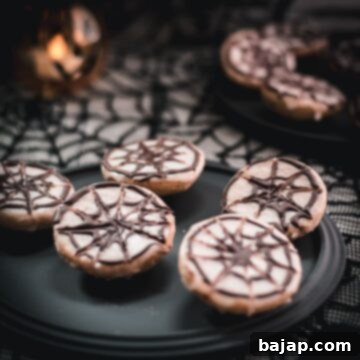
Halloween Spiderweb Cookies
Nora
Save RecipeSaved!
Pin Recipe
Equipment
-
Kitchen machine with whisk attachment
-
Mixing bowls
-
2 Baking trays & parchment paper
-
Piping bag
-
Cooling Rack
-
Toothpick
-
Whisk & fork for the glaze
-
Cake decorating pen
Ingredients
Cookie dough
- 3.5 oz Butter soft
- ½ cup Granulated sugar
- 2 teaspoon Vanilla sugar
- 1 pinch Salt
- 2 Eggs M
- ¼ cup Vanilla pudding powder 1.3 oz
- 2 cups Cake flour 8.82 oz
- 3 teaspoon Baking powder
- 3 tablespoon Milk
Glaze
- 1 cup Dark chocolate couverture for drawing the spiderweb
- 2 ¼ cups Powdered sugar
- 2 tablespoon Lemon juice
- 3 tablespoon Rice milk
Instructions
-
Preheat oven to 338°F (170°C) fan. Line two baking trays with baking paper.
-
Beat 3.5 oz Butter, ½ cup Granulated sugar, 2 teaspoon Vanilla sugar, and 1 pinch Salt until creamy with a food processor (whisk attachment).
-
Mix in 2 Eggs one at a time, followed by ¼ cup Vanilla pudding powder, 2 cups Cake flour, 3 teaspoon Baking powder, and 3 tablespoon Milk.
-
Pour the mixture into a piping bag without a tip and pipe 1.5-inch (4cm) cookies onto the trays.
-
Bake for 15 minutes, then cool on a rack.
-
Melt 1 cup Dark chocolate couverture using preferred method.
-
Whisk 2 ¼ cups Powdered sugar, 2 tablespoon Lemon juice and 3 tablespoon Rice milk until smooth for the icing.
-
Dip the flat side of cookies into icing. Use melted chocolate to make a dot and draw 2-3 circles.
-
Drag a toothpick from the center outward to create a spider web pattern.
-
Let dry on a cooling rack for about an hour.
Nutrition values are estimates only, using online calculators. Please verify using your own data.

⛑️ Important Food Safety Considerations
Ensuring food safety is paramount when preparing any meal or treat. Please keep these general guidelines in mind to protect yourself and your loved ones while baking your delicious Halloween spiderweb cookies:
- Cook to a minimum temperature of 165 °F (74 °C) to ensure any potentially harmful bacteria are killed. While cookies are generally baked, this is a good general rule.
- Do not use the same utensils on cooked food that previously touched raw ingredients without thorough washing.
- Always wash hands thoroughly with soap and warm water after handling raw ingredients like eggs.
- Avoid leaving food sitting out at room temperature for extended periods, especially those containing dairy or eggs.
- Never leave cooking food unattended; always monitor your oven while baking.
- When cooking or baking, use oils with a high smoking point to avoid the formation of harmful compounds, if applicable.
- Always ensure good ventilation in your kitchen, especially when using a gas stove or oven.
For further comprehensive information and detailed guidelines on safe food handling practices, please refer to the Safe Food Handling – FDA website.
